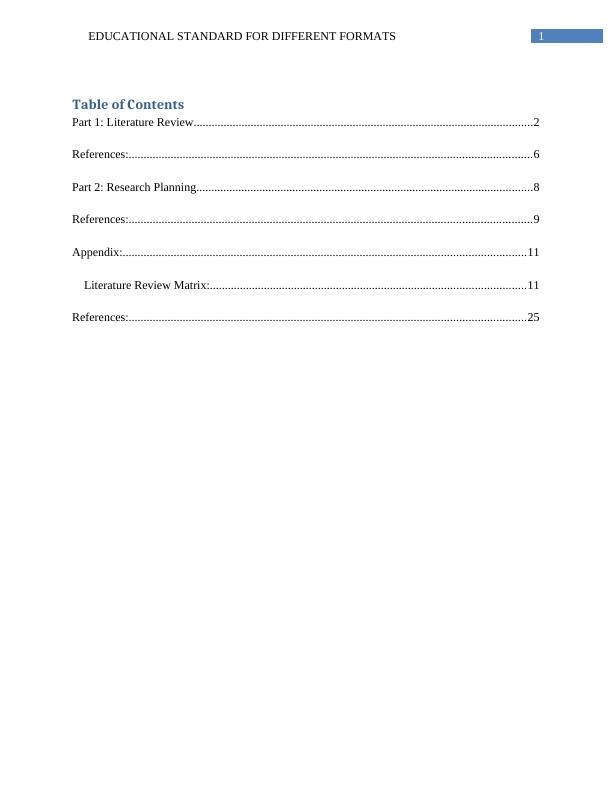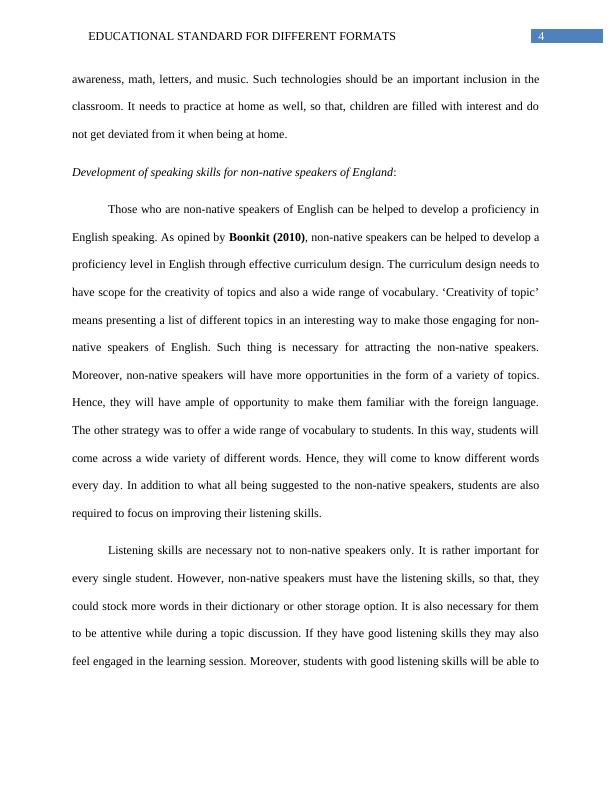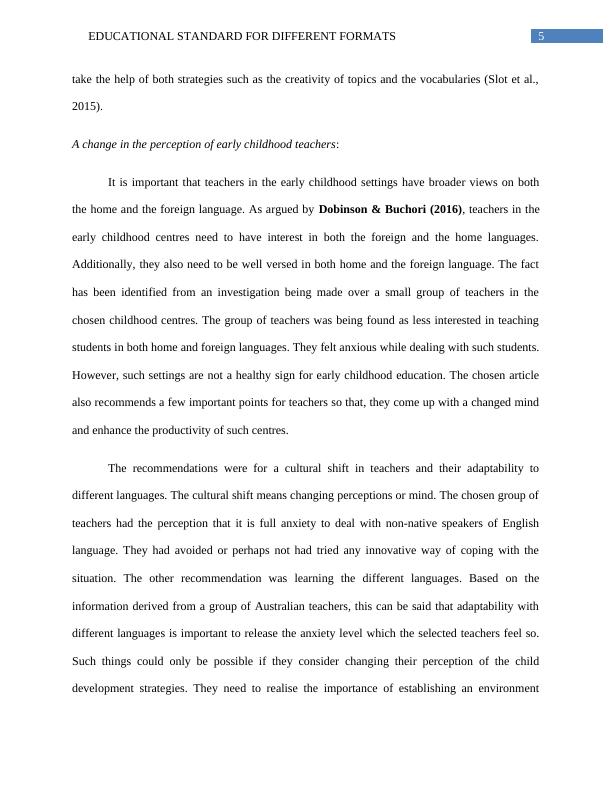Ways to Cope with Non-Native Speakers of English in Classroom - Literature Review and Research Planning
Added on 2023-06-13
26 Pages4933 Words332 Views
Running head: EDUCATIONAL STANDARD FOR DIFFERENT FORMATS
Ways to Cope with the Non-Native Speakers of English in Classroom
Name of the student:
Name of the university:
Author note:
Ways to Cope with the Non-Native Speakers of English in Classroom
Name of the student:
Name of the university:
Author note:

1EDUCATIONAL STANDARD FOR DIFFERENT FORMATS
Table of Contents
Part 1: Literature Review.................................................................................................................2
References:......................................................................................................................................6
Part 2: Research Planning................................................................................................................8
References:......................................................................................................................................9
Appendix:......................................................................................................................................11
Literature Review Matrix:.........................................................................................................11
References:....................................................................................................................................25
Table of Contents
Part 1: Literature Review.................................................................................................................2
References:......................................................................................................................................6
Part 2: Research Planning................................................................................................................8
References:......................................................................................................................................9
Appendix:......................................................................................................................................11
Literature Review Matrix:.........................................................................................................11
References:....................................................................................................................................25

2EDUCATIONAL STANDARD FOR DIFFERENT FORMATS
Part 1: Literature Review
Non-native speakers of English and its impact on native-speakers in primary schools in England:
Non-native speakers of English are often being considered as to have the negative
impacts on native speakers of English. A very same issue was being established by Geay,
McNally & Telhaj (2013) in the article “Non‐native Speakers of English in the Classroom:
What Are the Effects on Pupil Performance?” The article has noted a few criticisms being
shouted against the impact of non-native speakers in the classroom, in particular, the primary
classes in England. The evidence produced in support of the criticisms was like such non-native
speakers will need extra efforts from tutors. Hence, this is only spoilage to the productivity of the
education. Facts like the ethnic population are getting increased in the population were also
being highlighted as an issue. To justify whether the escalated issues are genuine, National Pupil
Database between 2003 and 2009 were being used. The results thus show non-native speakers
doing fairly better performance than the native speakers. Additionally, most ethnic minority
groups were progressed faster than the white British students. The improvement in terms of
proficiency in the English language was one of the major factors of success. It is also understood
that in most cases the primary students catch up in English proficiency at a very faster rate.
Hence, they do not impede the progress of other students especially the native-speakers of
English.
Evidence-based reform: enhancing language and literacy in early childhood education:
In the chosen article, early childhood education was thought to be as centred on reducing
the complexity level of different format of educational resources like the preschools. The
existing curriculum and the advancement of technology have not been sufficient in developing
Part 1: Literature Review
Non-native speakers of English and its impact on native-speakers in primary schools in England:
Non-native speakers of English are often being considered as to have the negative
impacts on native speakers of English. A very same issue was being established by Geay,
McNally & Telhaj (2013) in the article “Non‐native Speakers of English in the Classroom:
What Are the Effects on Pupil Performance?” The article has noted a few criticisms being
shouted against the impact of non-native speakers in the classroom, in particular, the primary
classes in England. The evidence produced in support of the criticisms was like such non-native
speakers will need extra efforts from tutors. Hence, this is only spoilage to the productivity of the
education. Facts like the ethnic population are getting increased in the population were also
being highlighted as an issue. To justify whether the escalated issues are genuine, National Pupil
Database between 2003 and 2009 were being used. The results thus show non-native speakers
doing fairly better performance than the native speakers. Additionally, most ethnic minority
groups were progressed faster than the white British students. The improvement in terms of
proficiency in the English language was one of the major factors of success. It is also understood
that in most cases the primary students catch up in English proficiency at a very faster rate.
Hence, they do not impede the progress of other students especially the native-speakers of
English.
Evidence-based reform: enhancing language and literacy in early childhood education:
In the chosen article, early childhood education was thought to be as centred on reducing
the complexity level of different format of educational resources like the preschools. The
existing curriculum and the advancement of technology have not been sufficient in developing

3EDUCATIONAL STANDARD FOR DIFFERENT FORMATS
language and literacy in early childhood education. The authors Slavin & Chambers (2017)
have identified that the existing developments in regards to curriculum design and others have
not been proved effective in the USA and the UK. However, an evidence based program can
really bring an improvement to the different levels of education. The attainment of the fact is
possible through following ways (Slavin & Chambers, 2017):
Some pre-literacy activities in early childhood education: Some activities can really help
to uplift the standard of early childhood education. Few such activities can be like early phonics
and phonemic awareness. Such activities have been found as effective in terms of language
proficiency development. The longstanding concern that introducing literacy at the early ages
may affect the development in other areas has not been found as true. However, the article
suggests having a feasible way of that. The introduction to different kinds of literacy needs to be
done with the help of appropriate technologies and strategies to make it look attractive and
engaging as well.
Building vocabulary in children: Vocabulary needs to be the prime focus for children in
preschools especially to students of English. This means making children familiar with the body
of words specific to one language. This can be done by creating new opportunities for children
learning in preschools. There is a need for a structured design that creates a moment to get
indulged in and learn a new set of words every single day.
Use of the appropriate technologies: Technology can be used to make the learning
sessions engaging. It does not mean hampering the exchange of communication between
teachers and the children. It rather means making curriculum more productive. The idea behind
the technological intervention is to increase the time spent limit of children on themes, phonemic
language and literacy in early childhood education. The authors Slavin & Chambers (2017)
have identified that the existing developments in regards to curriculum design and others have
not been proved effective in the USA and the UK. However, an evidence based program can
really bring an improvement to the different levels of education. The attainment of the fact is
possible through following ways (Slavin & Chambers, 2017):
Some pre-literacy activities in early childhood education: Some activities can really help
to uplift the standard of early childhood education. Few such activities can be like early phonics
and phonemic awareness. Such activities have been found as effective in terms of language
proficiency development. The longstanding concern that introducing literacy at the early ages
may affect the development in other areas has not been found as true. However, the article
suggests having a feasible way of that. The introduction to different kinds of literacy needs to be
done with the help of appropriate technologies and strategies to make it look attractive and
engaging as well.
Building vocabulary in children: Vocabulary needs to be the prime focus for children in
preschools especially to students of English. This means making children familiar with the body
of words specific to one language. This can be done by creating new opportunities for children
learning in preschools. There is a need for a structured design that creates a moment to get
indulged in and learn a new set of words every single day.
Use of the appropriate technologies: Technology can be used to make the learning
sessions engaging. It does not mean hampering the exchange of communication between
teachers and the children. It rather means making curriculum more productive. The idea behind
the technological intervention is to increase the time spent limit of children on themes, phonemic

4EDUCATIONAL STANDARD FOR DIFFERENT FORMATS
awareness, math, letters, and music. Such technologies should be an important inclusion in the
classroom. It needs to practice at home as well, so that, children are filled with interest and do
not get deviated from it when being at home.
Development of speaking skills for non-native speakers of England:
Those who are non-native speakers of English can be helped to develop a proficiency in
English speaking. As opined by Boonkit (2010), non-native speakers can be helped to develop a
proficiency level in English through effective curriculum design. The curriculum design needs to
have scope for the creativity of topics and also a wide range of vocabulary. ‘Creativity of topic’
means presenting a list of different topics in an interesting way to make those engaging for non-
native speakers of English. Such thing is necessary for attracting the non-native speakers.
Moreover, non-native speakers will have more opportunities in the form of a variety of topics.
Hence, they will have ample of opportunity to make them familiar with the foreign language.
The other strategy was to offer a wide range of vocabulary to students. In this way, students will
come across a wide variety of different words. Hence, they will come to know different words
every day. In addition to what all being suggested to the non-native speakers, students are also
required to focus on improving their listening skills.
Listening skills are necessary not to non-native speakers only. It is rather important for
every single student. However, non-native speakers must have the listening skills, so that, they
could stock more words in their dictionary or other storage option. It is also necessary for them
to be attentive while during a topic discussion. If they have good listening skills they may also
feel engaged in the learning session. Moreover, students with good listening skills will be able to
awareness, math, letters, and music. Such technologies should be an important inclusion in the
classroom. It needs to practice at home as well, so that, children are filled with interest and do
not get deviated from it when being at home.
Development of speaking skills for non-native speakers of England:
Those who are non-native speakers of English can be helped to develop a proficiency in
English speaking. As opined by Boonkit (2010), non-native speakers can be helped to develop a
proficiency level in English through effective curriculum design. The curriculum design needs to
have scope for the creativity of topics and also a wide range of vocabulary. ‘Creativity of topic’
means presenting a list of different topics in an interesting way to make those engaging for non-
native speakers of English. Such thing is necessary for attracting the non-native speakers.
Moreover, non-native speakers will have more opportunities in the form of a variety of topics.
Hence, they will have ample of opportunity to make them familiar with the foreign language.
The other strategy was to offer a wide range of vocabulary to students. In this way, students will
come across a wide variety of different words. Hence, they will come to know different words
every day. In addition to what all being suggested to the non-native speakers, students are also
required to focus on improving their listening skills.
Listening skills are necessary not to non-native speakers only. It is rather important for
every single student. However, non-native speakers must have the listening skills, so that, they
could stock more words in their dictionary or other storage option. It is also necessary for them
to be attentive while during a topic discussion. If they have good listening skills they may also
feel engaged in the learning session. Moreover, students with good listening skills will be able to

5EDUCATIONAL STANDARD FOR DIFFERENT FORMATS
take the help of both strategies such as the creativity of topics and the vocabularies (Slot et al.,
2015).
A change in the perception of early childhood teachers:
It is important that teachers in the early childhood settings have broader views on both
the home and the foreign language. As argued by Dobinson & Buchori (2016), teachers in the
early childhood centres need to have interest in both the foreign and the home languages.
Additionally, they also need to be well versed in both home and the foreign language. The fact
has been identified from an investigation being made over a small group of teachers in the
chosen childhood centres. The group of teachers was being found as less interested in teaching
students in both home and foreign languages. They felt anxious while dealing with such students.
However, such settings are not a healthy sign for early childhood education. The chosen article
also recommends a few important points for teachers so that, they come up with a changed mind
and enhance the productivity of such centres.
The recommendations were for a cultural shift in teachers and their adaptability to
different languages. The cultural shift means changing perceptions or mind. The chosen group of
teachers had the perception that it is full anxiety to deal with non-native speakers of English
language. They had avoided or perhaps not had tried any innovative way of coping with the
situation. The other recommendation was learning the different languages. Based on the
information derived from a group of Australian teachers, this can be said that adaptability with
different languages is important to release the anxiety level which the selected teachers feel so.
Such things could only be possible if they consider changing their perception of the child
development strategies. They need to realise the importance of establishing an environment
take the help of both strategies such as the creativity of topics and the vocabularies (Slot et al.,
2015).
A change in the perception of early childhood teachers:
It is important that teachers in the early childhood settings have broader views on both
the home and the foreign language. As argued by Dobinson & Buchori (2016), teachers in the
early childhood centres need to have interest in both the foreign and the home languages.
Additionally, they also need to be well versed in both home and the foreign language. The fact
has been identified from an investigation being made over a small group of teachers in the
chosen childhood centres. The group of teachers was being found as less interested in teaching
students in both home and foreign languages. They felt anxious while dealing with such students.
However, such settings are not a healthy sign for early childhood education. The chosen article
also recommends a few important points for teachers so that, they come up with a changed mind
and enhance the productivity of such centres.
The recommendations were for a cultural shift in teachers and their adaptability to
different languages. The cultural shift means changing perceptions or mind. The chosen group of
teachers had the perception that it is full anxiety to deal with non-native speakers of English
language. They had avoided or perhaps not had tried any innovative way of coping with the
situation. The other recommendation was learning the different languages. Based on the
information derived from a group of Australian teachers, this can be said that adaptability with
different languages is important to release the anxiety level which the selected teachers feel so.
Such things could only be possible if they consider changing their perception of the child
development strategies. They need to realise the importance of establishing an environment

End of preview
Want to access all the pages? Upload your documents or become a member.
Related Documents
Developing Early Literacy: Assessment and Teachinglg...
|9
|1857
|394
